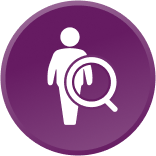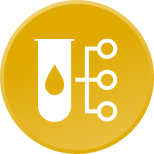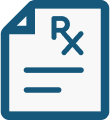Developing drugs with you in mind
Clinical trials, also called clinical studies, are the key to getting FDA approval for any drug. These studies depend on volunteer participants to help gather the scientific evidence to determine whether a new drug is safe and effective.
In this section, find out more about clinical trials and how you might be able to take part in one.
Establishing the safety and effectiveness of drugs in development
The FDA has strict rules that govern how new drugs are studied and approved. Clinical trials must be performed to provide scientific evidence that a drug is both safe and effective for human use. Clinical trials are research studies that are designed to test:
- the safety and possible side effects of a drug
- the drug’s most effective and safe dose
- the impact of the drug on the condition
- how the drug might compare to other treatments
Before it has been approved, every drug—whether it’s one that you can buy over the counter at your local grocery store or a cutting-edge therapy—must go through a series of rigorous tests.

Trial design: gathering information, measuring results
Clinical trials are designed to measure specific goals called endpoints. These endpoints help the investigators understand how the investigational product performs, and its potential benefits and risks to participants. There are 2 types of endpoints:

Clinical endpoints directly measure whether you feel better, function better, or live longer with the treatment.

Surrogate endpoints use biomarkers that are believed to indicate clinical benefit. They use biomarkers—a physical, biochemical, or genetic characteristic that can be objectively measured.
An indicator or sign used in place of another to tell if a treatment works.
A molecule found in blood, body fluids, or tissue that is a sign of a normal or abnormal process, or of a condition or disease.
Who can participate?
Each study has a set of rules that defines who is able (eligible) or not able (ineligible) to participate. These rules are put in place to make sure that the people in the study are similar enough to each other that the study results make sense. They also maximize the possibility of seeing a treatment effect and minimize risk to the study subjects. If the participants are very different from each other in the beginning of the study, then the results can be confusing to understand.
Study eligibility criteria might include:
- age within a defined range
- gender
- type of genetic mutation
- type, severity, and stage of the condition
- overall health status
- performance on certain tests
- ability to participate in tests that are required in the study
Another reason for these rules is to reduce the risk of harm to a participant. Some people who are interested in participating in a study may be excluded because they have certain risk factors.
Examples of ineligibility may include:
- age or ability outside the defined limit of the study
- other health conditions that may complicate the understanding of the safety of an investigational product
- use of certain current or former treatments or medications
Learn the pros and cons
Before you decide if you want to take part in a clinical study, it’s important to learn all you can about the study and its goals. This includes getting the details not only about the potential benefits of participation, but also about any risks that might be experienced.

Benefits
- Potential access to investigational treatments being studied in research
- Regularly scheduled medical attention from a team of healthcare professionals
- Participating in research that may result in advancing the understanding and treatment of the condition
- Playing a part in the approval of an investigational treatment

Risks
- The investigational treatment may have side effects—including some serious ones
- Some participants may be given a placebo (a pill or liquid that has no active ingredients) instead of the drug being studied
- The procedure for the investigational treatment may take more time or be more complicated than routine treatments; participants may need regular testing, frequent check-ins, or a hospital stay
- The investigational treatment may not work
Do you have questions about clinical trials?

Your involvement matters
Taking part in a clinical study is a unique experience—a chance to be part of something important. This is research that can advance our understanding of rare conditions and potentially help bring a new treatment to people who need it. It’s especially important in rare conditions, where it’s a challenge to find enough study participants to gather the data needed to answer the scientific questions we are asking.
To learn more about how to participate in clinical studies, speak to your doctor, visit clinicaltrials.gov, or contact us at advocacy@sarepta.com.
The pathway of drug development in rare conditions
It is a long road to approval for all new investigational products, but in rare conditions like Duchenne or the LGMDs, new products have unique challenges to overcome. Researchers and investigators work to ensure that from the laboratory to the doctor’s office, each investigational product is well studied to learn more about its safety and efficacy.
The graphic below shows the path of development for a new investigational product in rare conditions.
Moving forward, one step at a time

1. RESEARCH
Scientists in the laboratory discover a new compound.

2. PRE-CLINICAL
Researchers test the investigational product’s safety and the effect it has in animals.

3. EARLY-STAGE CLINICAL
Investigators study the dosage and effect of the investigational product in small groups of people. Safety and side effects are also recorded.

4. LATE-STAGE CLINICAL
Larger groups of people who have the condition being studied receive the investigational product. These studies help to confirm whether the product is effective and to establish its safety profile (including side effects). These studies may also compare the product with a placebo or with current or similar treatments.

5. APPROVAL
After FDA review, the new product may receive approval for doctors to prescribe it.

6. REAL WORLD EVIDENCE (RWE) STUDIES
After approval, studies continue to follow participants over time, gathering real-world, evidence-based information.
What to expect if you join a clinical study
As explained above, each study has rules about who can be included and who cannot. When you ask a study investigator about joining, you will be asked to answer a lot of questions about your health, the kind of condition you have, and the treatments you’ve already had. If you are a good fit based on how the study is designed, you could be eligible to enroll.
Every study will be different, but there are certain things that are similar. You will learn all the details you need from the study staff in order to make a decision on whether to participate in a clinical study, including:

Informed consent: You will receive information about how the study will be run, the goals of the study, and risks involved, so you know what to expect

Length of commitment: Some studies are only a few weeks or months long, while others may take years, and may also include long‑term follow‑up

What might be required: You may need to travel, stay in a hospital, or have more tests and regular exams than you normally would

Additional responsibilities: You may be asked to keep a health journal, fill out forms on a regular basis, or provide other types of reporting
Once you have all the information you need and have consulted with your healthcare provider, and if you have decided that participation is right for you and your family, you will be asked to sign an informed consent document. This document ensures that you understand the information you’ve been given. Be sure to spend time learning about what taking part in the study will involve, and ask as many questions as you need to fully understand what you are signing up for.
In some studies, for comparison purposes, a participant may receive either the active investigational product or a placebo (a pill or liquid that has no active ingredients). In rare or severe conditions, the investigational product is sometimes compared to the most commonly used, currently available treatment. To ensure fairness and objectivity, these studies are double-blind, which means that neither the participant nor the investigator knows who is receiving the active product or the placebo.
Occasionally, and more frequently in a rare condition, regulators will allow study sponsors to design studies that do not compare an investigational product’s effect against a placebo, but instead, compare against other data that has been collected (natural history, data from other placebo groups, or other measures).
After the study ends: what’s next?

After the study ends, all the collected data are closely evaluated. Investigators review how participants responded to the investigational product, including side effects related to its use and what benefits might have been seen. Detailed reports are sent to the FDA, which will determine whether the product should be approved for use, and in what populations.
Even if the study shows that the investigational product doesn’t improve patients’ outcomes, or if the product is not approved by the FDA, the study will still have provided new information. Your participation will help to move research forward with new knowledge that can be used in future studies or in the design of new investigational products.
Are you interested in learning more?
If you or a loved one is interested in taking part in a clinical study, talk with your doctor. You can learn which study might be a good match for you, and how to apply.
Because studies have strict rules about who may participate, you may not be selected. However, there may be another study that you would be eligible for, so don’t give up. Many people find it helpful to join an advocacy organization that is focused on their condition in order to:
- understand what is happening in treatment developments
- learn about new studies that may be recruiting
- connect with other people in their community
To learn more about how to take part in Sarepta clinical studies,
contact us at advocacy@sarepta.com.
Explore additional clinical study opportunities at clinicaltrials.gov, a listing of all U.S. clinical studies now underway. This resource lets you search for new studies by the name of the investigational product being studied, the name of a condition, or the specific name of a study.
See the most frequently asked questions about clinical studies.
